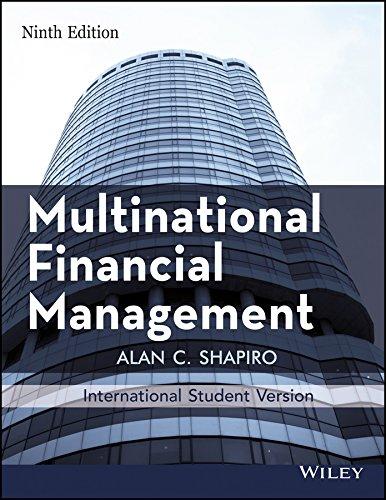Question
1. Data: This project makes use of annual data for two risky securities: the S&P 500 Index and Gold. Annual values for each of these

1. Data: This project makes use of annual data for two risky securities: the S&P 500 Index and Gold. Annual values for each of these securities during the period from 1975-2018 are provided in a spreadsheet posted on Blackboard.
You should use an annual risk-free rate of 4% for this project.
2. Return Calculations: Calculate annual returns for each of the two securities from 1976 through 2018. Calculate the average annual return, the standard deviation of annual returns, and the correlation between the returns of the two securities during this period and fill in the table provided. (Note: all of these calculations are based on annual security % returns NOT index values). Attach the spreadsheet showing all of the relevant calculations as Exhibit 1.
S&P 500 Gold
Average Annual Return
Standard Deviation of Annual Returns
Return Correlation(S&P,Gold)
Some useful Excel functions: to compute average return, use the function AVERAGE; for standard deviation, use STDEV; for correlation, use CORREL.
3. Capital Allocation Lines: Assume that the mean return, standard deviation, and correlation estimates you calculated above provide a reasonable forecast of the expected returns and risks of these securities for the coming year. Based on these forecasts, plot the two risky securities on an expected return - standard deviation graph. Also, plot the risk-free security. Be sure to label all three securities on the graph. Draw the Capital Allocation Line for each of the risky securities (S&P and Gold). Attach the graph as Exhibit 2.
4. Risky Portfolios: Calculate the expected returns and standard deviations of portfolios that combine the two risky securities (S&P and Gold), varying weights from 0% to 100% in increments of 5% (note: this should result in 21 portfolios). Attach the spreadsheet showing all relevant calculations as Exhibit 3.
5. The Opportunity Set and the Tangency Portfolio: Plot the risk-free security and the 21 portfolios described in question 4 on an expected return - standard deviation graph. Be sure to clearly label the S&P 500, Gold, and the risk-free security on the graph. Identify and label the minimum variance portfolio on the graph. Identify and label the optimal risky portfolio (a.k.a. the tangency portfolio) on the graph and draw the Capital Allocation Line (CAL) for this portfolio. Attach the graph as Exhibit 4.
(a) What are the portfolio weights in the Tangency Portfolio? What are the mean and standard deviation of the Tangency Portfolio?
(b) What are the portfolio weights in the Minimum Variance Portfolio? What are the mean and standard deviation of the Minimum Variance Portfolio?
(c) What are the portfolio weights in the Equal-Weighted Portfolio? What are the mean and standard deviation of the Equal-Weighted Portfolio?
1981 DATES&P 500 IndexGold Prices 90.19 139.30 107.46 133.80 95.10 160.45 1978 96.11 207.83 1979 107.94 455.08 1980 135.76 594.92 122.55 410.09: 1982 140.64 444.30 1983 164.93 389.36 1984 167.24 320.14 1985 211.28 320.81 1986 242.17 391.23 1987 247.08 486.31 1988 277.72 418.49 1989 353.40 409.39 1990 330.22 378.16 1991 417.09 361.06 1992 435.71 334.80 1993 466.45 383.35 1994 459.27 379.29 1995 615.93 1996 740.74 1997 970.43 1998 1229.23 29162 1999 1469.25 282.37 2000 1320.28 271.45 2001 1148.08 275.45 2002 798.55 321.18 2003 1111.92 417.25 2004 1211.92 435.60 2005 1248.29 513.00 2006 1418.30 635.70 2007 1468.36 836.50 2008 903.25 869.75 2009 1115.10 1087.50 2010 1257.64 1420.25 2011 1257.60 153100: 2012 1426.19 1664.00 2013 1848.36 2014 2058.90 1135.80 2015 2043.94 1060.30 2016 2238.83 106119: 2017 2673.61 ........2018.................2506.85... 12816 387.44 369.00 288 1204.50 1236.50 1981 DATES&P 500 IndexGold Prices 90.19 139.30 107.46 133.80 95.10 160.45 1978 96.11 207.83 1979 107.94 455.08 1980 135.76 594.92 122.55 410.09: 1982 140.64 444.30 1983 164.93 389.36 1984 167.24 320.14 1985 211.28 320.81 1986 242.17 391.23 1987 247.08 486.31 1988 277.72 418.49 1989 353.40 409.39 1990 330.22 378.16 1991 417.09 361.06 1992 435.71 334.80 1993 466.45 383.35 1994 459.27 379.29 1995 615.93 1996 740.74 1997 970.43 1998 1229.23 29162 1999 1469.25 282.37 2000 1320.28 271.45 2001 1148.08 275.45 2002 798.55 321.18 2003 1111.92 417.25 2004 1211.92 435.60 2005 1248.29 513.00 2006 1418.30 635.70 2007 1468.36 836.50 2008 903.25 869.75 2009 1115.10 1087.50 2010 1257.64 1420.25 2011 1257.60 153100: 2012 1426.19 1664.00 2013 1848.36 2014 2058.90 1135.80 2015 2043.94 1060.30 2016 2238.83 106119: 2017 2673.61 ........2018.................2506.85... 12816 387.44 369.00 288 1204.50 1236.50Step by Step Solution
There are 3 Steps involved in it
Step: 1

Get Instant Access to Expert-Tailored Solutions
See step-by-step solutions with expert insights and AI powered tools for academic success
Step: 2

Step: 3

Ace Your Homework with AI
Get the answers you need in no time with our AI-driven, step-by-step assistance
Get Started


